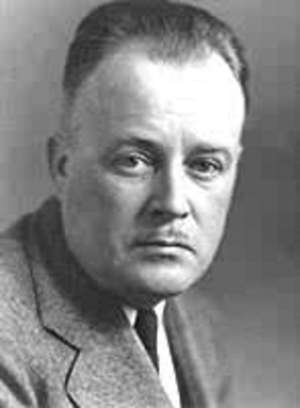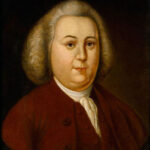Behind the rugged exterior of the Ozarks lies a rich history, a past steeped in tradition and folklore. The way of life that brought the first settlers into these hills has vanished but the legacy lives on thanks to the lifelong efforts of Vance Randolph. Noted in academic and folklore circles as the foremost authority on Ozark folklore, Vance Randolph was a native of Pittsburg, Kansas. He first visited the Ozarks as a young child but the region and its’ people became his passion. By 1920 he made his home in the Ozark Mountains and lived in the Ozarks until his death in 1980. During those sixty years, Randolph preserved the past; capturing the essence of the Ozark natives before it vanished into the ethers of the 20th century.
He was born on February 23, 1892 in Pittsburg at a time when that small city was growing from a booming mining camp into a city that offered many modern amenities. His mother, the former Theresa Gould, had been a public school teacher and his father, John Randolph was a noted local lawyer and Republican politician. Although Pittsburg was not far – fifty or sixty miles in distance – from the more remote regions of the Ozarks, it was a completely different world. In Pittsburg and in the Randolph home, the amenities of the early 20th century were readily available but southeast in the Ozark country, many families still lived the way that the earliest settlers had lived. Log cabins, open hearths for cooking, and self-reliance were still a way of life in the Ozarks. This fascinated young Vance Randolph and sowed the seed for his life’s work.
As the oldest of three Randolph sons, Vance was often a disappointment to his parents. Although very intelligent, he dropped out of high school at an early age and began writing for left leaning periodicals published in nearby Girard, Kansas. One of these publications, The Appeal to Reason, was the Socialist voice of America. Some of the authors who contributed to the controversial publication were Karl Marx, Upton Sinclair, and Eugene Debs. Sinclair was commissioned by the journal to write The Jungle, a classic novel that not only delivered a hard hitting Socialist message but led to early reforms in the meat packing industry.
In 1914, Randolph, despite his lack of a high school education, graduated from the college that would become Pittsburg State University. He then completed his MA work at Clark University. He sought to attend graduate school at Columbia University but he failed to gain faculty support for his desire to study Ozark mountain folk.
After many visits to the Ozarks, Randolph made the area his home in 1920. He made Pineville, Missouri his home and later married a local woman, Marie Wardlaw Wilbur. In the introduction to his book, Down In The Holler: A Gallery of Ozark Folk Speech Randolph writes, “By marriage and otherwise I associated myself with several old backwoods families.” He then describes how he traveled through the Missouri and Arkansas Ozark region to collect folklore. Although rudimentary roads made travel into the most remote areas difficult, Randolph traveled on horseback, in wagons, and in what he called “a rattletrap Ford”.
He made his living by writing for sporting magazines, as an author of juvenile books, and by writing for the Little Blue Books series. Although almost forgotten by most, the Little Blue Books were published in Girard, Kansas after the former editor of The Appeal To Reason bought the publishing house from his employer. The Little Blue Books were small, low priced paperback books designed for the working classes. Prices for the books were often as low as a nickel and the St. Louis Post-Dispatch called Emmanuel Haldeman-Julius, their creator, “the Henry Ford of literature.
Randolph used pseudonyms on his “hack work” but when he began to publish articles on Ozark folklore, his byline appeared under his own name. Randolph’s first published article on folklore appeared in the Journal of American Folklore in 1927. During the next two decades, his articles began to appear on a regular basis in another folklore journal, American Speech and Dialect Notes.
Randolph first became interested in the unique dialect of the Ozark natives in 1915 and soon realized that although their speech often seemed ignorant to outside ears, many of the words and colloquialisms heard throughout the Ozarks had been handed down for generations. The origins of many words and common usages dated back to England, to Shakespeare’s era and even to Chaucer in the infancy of the modern English language. Words like ruinate, gaum, and misdoubt date back centuries. Even words often perceived as mispronunciations such as “ketch” for catch or “axe “for ask can be traced to Chaucer’s writings. As he collected bits of dialect, he grew interested in other facets of daily life, in folklore beliefs about weather, medicine, and more.
In February of 1941, Vance Randolph was contacted by Alan Lomax, then head of the Archive of American Folk Songs at the Library of Congress and asked if he would consider making field recordings in the Ozarks. Randolph agreed and collected more than 870 selections. Today, the Vance Randolph Collection is the definitive source for Ozark folk music at the Library of Congress. His efforts preserved many ballads and songs that had been handed down over many generations, songs which might have been lost to posterity with the advent of radio.
His four volume collection of folk songs was published by the Missouri State Historical Society; this in addition to the recordings at the Library of Congress. He made his home in the Pineville area for many years but in the 1940’s and 1950’s he lived in Arkansas, in Carroll County near Eureka Springs and in the Fayetteville area.
Although his wife died in 1937, Randolph carried on his work and in 1947, his first major book, Ozark Superstitions, was published in 1947. The book remains in print today with the title Ozark Magic and Superstitions. His Down In the Holler: A Gallery of Ozark Folk Speech was published to academic acclaim in 1953. Although he penned several other volumes about the Ozark country, one of his books that presented Ozark folk tales became a best seller. Pissing In The Snow, published in 1976, remains popular. Like another book of Ozark folk tales, Stiff As A Poker, the book recounts oral folk stories as told by Ozark residents, many of which could not read or write.
In all of Randolph’s works, the names of places he collected information are familiar to long time residents of the Ozarks. Neosho, Missouri is mentioned as are many places in McDonald County. Sites in and around the Branson area include Blue Eye, Forsythe and Crane. In Arkansas, the small town of Fouke along with both Benton and Washington Counties are just a few of the locations mentioned.
He married again in 1962 to Mary Celestia Parler, an English professor and folklore researcher at the University of Arkansas. Randolph was made a Fellow of the American Folklore Society in 1978, wrote numerous additional books on Ozark culture and served on the advisory board of Bittersweet, a magazine about Ozark folklore.
Randolph died on November 1, 1980 at the age of 88 after more than sixty years of collecting folklore and preserving the Ozarks past for posterity.
His lifelong work stands as the definitive work in Ozark folklore. He wrote down the superstitions, the beliefs, the tall tales, the bawdy stories, and ghost stories so that future generations could know the past. Randolph also preserved the songs, the medical lore, and the cadences of traditional Ozark speech. As he wrote in the introductory pages of Ozark Superstitions, “where ever railroads and highways penetrate, wherever newspapers and movies and radios are introduced the people gradually lose their distinctive local traits and assume the drab color that characterizes conventional Americans everywhere.”
He could not halt progress but he could – and did – save what he could for history and maintained the true flavor, the original glory of these Ozark hills. Earlier generations will live forever in the works he collected and contribute to the future.





